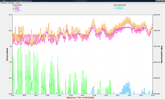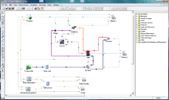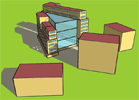What is TRNSYS?
TRNSYS (pronounced 'tran-sis') is an extremely flexible graphically based software environment used to simulate the behavior of transient systems. While the vast majority of simulations are focused on assessing the performance of thermal and electrical energy systems, TRNSYS can equally well be used to model other dynamic systems such as traffic flow, or biological processes.
TRNSYS is made up of two parts. The first is an engine (called the kernel) that reads and processes the input file, iteratively solves the system, determines convergence, and plots system variables. The kernel also provides utilities that (among other things) determine thermophysical properties, invert matrices, perform linear regressions, and interpolate external data files. The second part of TRNSYS is an extensive library of components, each of which models the performance of one part of the system. The standard library includes approximately 150 models ranging from pumps to multizone buildings, wind turbines to electrolyzers, weather data processors to economics routines, and basic HVAC equipment to cutting edge emerging technologies. Models are constructed in such a way that users can modify existing components or write their own, extending the capabilities of the environment.
After 35 years of commercial availability, TRNSYS continues to be a flexible, component-based software package that accommodates the ever-changing needs of both researchers and practitioners in the energy simulation community.
Applications

TRNSYS has an extensive cross section of users worldwide that spans from researchers to consultants, engineers to building simulation experts, and students to architects. Because of the wide user-base, the tool's long history, and its inherent flexibility, it is actively being used in many of the following applications:
- Central Plant Modeling
- Building Simulation (including LEED Energy Modeling)
- Solar Thermal Processes
- Ground Coupled Heat Transfer
- High Temperature Solar Applications
- Geothermal Heat Pump Systems
- Coupled Multizone Thermal/Airflow Modeling
- Optimization
- Energy System Research
- Emerging Technology Assessment
- Power Plants (Biomass, Cogeneration)
- Hydrogen Fuel Cell Systems
- Wind and Photovoltaic Systems
- Data and Simulation Calibration


